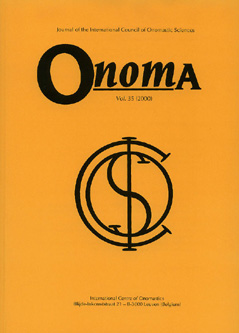 previous article in this issue previous article in this issue | next article in this issue  |

Preview first page |
Document Details : Title: Some Reflections on the Relation between Toponymy and Geography Author(s): TORT-DONADA, Joan Journal: Onoma Volume: 45 Date: 2010 Pages: 253-276 DOI: 10.2143/ONO.45.0.2182826 Abstract : This article seeks to present a synthesis of the relations maintained between toponymy and geography throughout their history. Despite obvious differences in their epistemologies, these two fields of knowledge (where toponymy is considered one of the two main branches of onomastics, along with anthroponymy) present a marked degree of affinity in various facets, in their respective approaches and in the diversity of their objects of study. The starting point for this discussion is quite simply stated: toponymy and geography clearly share a common background – namely, the concept of topos. That is, the word of Greek origin that constitutes the classical way of referring to the place (at all scales) where we as humans inhabit and live out our lives. The interactions between toponymy and geography have been both extensive and intense in nature, and have been of great significance throughout the ages. Place names are in themselves complex concepts, and are open to a multiplicity of approaches. On the other hand, geography is a discipline which has an intrinsic interest in space, but also in time (present and past). For this reason, its specific way of seeing things is characterised by what is simultaneously a synchronic and a diachronic approach. However, for motives related to the history and the general development of the research of place names, toponymy is in many cases primarily concerned with analyses conducted from a linguistic and philologic perspective. Yet geography and history should also play a key role in attaining a multidisciplinary approach to onomastics. Facing the future, and from a global conception of science, we need to see this set of circumstances not as a problem but rather as an advantage for our research, as it takes us in different, yet complementary, directions. Dans cet article nous essayons de présenter une réflexion synthétique sur la relation que, dans un sens historique, la toponymie et la géographie ont soutenue. Ces deux champs de la connaissance (à condition que la toponymie est l’une des deux principales branches de l’onomastique, étant l’anthroponymie l’autre), en dépit de leurs différences dans le sens épistémologique, montrent un degré important d’affinité dans certains de leurs aspects, dans les respectifs approches et dans leur diversité d’objets d’étude. Le point de départ que nous adoptons pour notre réflexion est très simple: entre la toponymie et la géographie il y a un clair fond commun, le concept et l’idée de topos. C’est-à-dire: le mot d’origine grecque qui constitue la forme classique de se référer aux lieux (à différentes échelles) où nous vivons ou que nous prenons comme référence à notre relation. Les interactions entre la toponymie et la géographie sont nombreuses et intenses, et ont eu une grande importance à travers le temps. Le nom de lieu est en soi un concept complexe, et accepte une multitude d’approches. Par l’autre côté, la géographie est en soi une discipline spécialement préoccupée par l’espace, mais aussi par le temps (présent et passé), et pour cette raison sa manière spécifique de regarder le monde a à la fois un sens synchronique et diachronique. En revanche, pour des raisons liées à l’histoire et l’évolution générale de la recherche, dans l’étude de la toponymie ont été surtout important des analyses faites à partir du point de vue de la linguistique et la philologie. Mais la géographie et l’histoire ont aussi un rôle clé si nous voulons atteindre une véritable approche multidisciplinaire à l’onomastique. Face à l’avenir, et dans une perspective globale de la science, nous devons examiner ce cas pas comme un problème mais comme un atout pour la recherche, dans différentes et complémentaires directions. Im folgenden Artikel wird eine synthetische Überlegung über die historische Beziehung der Toponymie zur Geografie präsentiert. Trotz der offensichtlichen Unterschiede in deren Epistemologie, weisen die beiden Wissenschaften (wobei angenommen wird, dass die Toponymie, neben der Anthroponymie, eine der zwei wichtigsten Zweige der Onomastik einnimmt) einen Grad an Verwandtschaft in einigen Facetten auf, wie in deren Forschungsansatz und deren vielfältigen Zielen. Das Konzept für die Diskussion dieser Thematik ist relativ einfach: Die Toponymie und die Geografie besitzen eine gemeinsame Basis - nämlich das Konzept topos. Sozusagen das Ursprungswort aus dem Griechischen für die klassische Bezeichnung eines Orts (in verschiedenen Maßstäben), an dem wir, die Menschen, wohnen und unser Leben verbringen. Die Wechselwirkungen zwischen der Toponymie und der Geographie waren ursprünglich umfangreich und intensiv und hatten lange Zeit eine große Bedeutung. Ortsnamen repräsentieren komplexe Konzepte und bieten Möglichkeit für eine Vielfalt von Untersuchungsansätzen. Die Geographie ist dabei eine Wissenschaft die stark mit dem Raum verbunden ist, aber auch mit der Zeit (sowohl Vergangenheit als auch Zukunft). Aus diesem Grund ist der spezielle Betrachtungswinkel der Geografie gekennzeichnet von einem gleichzeitigen synchronischen und diachronischen Ansatz. Nichts desto trotz wird die Toponymie aus Gründen der historischen und generellen Entwicklung der Ortsnamenforschung hauptsächlich mit der Analyse der linguistischen und philologischen Aspekte in Verbindung gesetzt. Tatsächlich sollte aber die Geografie und die Geschichte ebenso eine Schlüsselrolle für einen multi-disziplinären Forschungsansatz im Bereich der Onomastik inne haben. In Hinsicht auf die Zukunft, und aus einer globalen Perspektive der Wissenschaft gesehen, ist es notwendig diese Umstände nicht als ein Problem zu sehen, sondern als ein Vorteil für unsere Forschung, da sie uns in verschiedene, sich ergänzende Richtungen führt. |
|


